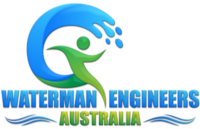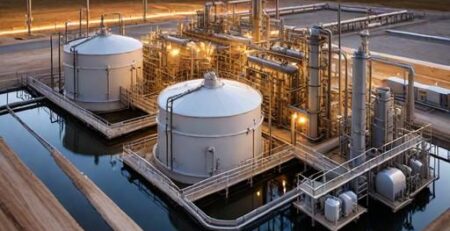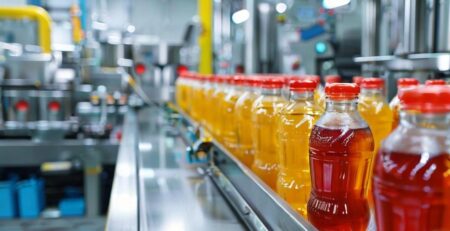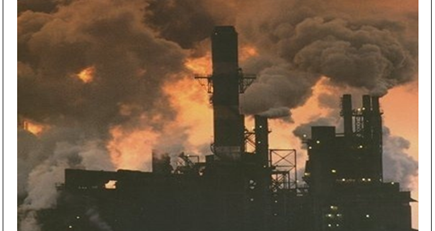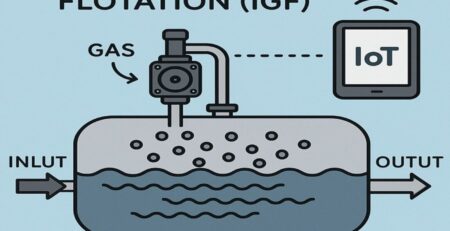Mechanical Evaporators for Mining Wastewater Treatment, FOG CANON
Mechanical Evaporators for Mining Wastewater Treatment, FOG CANON
1. Introduction
The mining industry, especially in metal extraction, coal processing, and mineral refining, produces large quantities of wastewater contaminated with a complex mix of pollutants such as dissolved salts, heavy metals, sulfates, and acid-generating compounds. Effective and sustainable treatment of this wastewater is essential to:
- Prevent contamination of groundwater and surface water bodies.
- Meet increasingly stringent environmental discharge standards.
- Reduce the environmental footprint of mining operations.
Mechanical evaporators are emerging as an essential solution for wastewater management, particularly in achieving Zero Liquid Discharge (ZLD), reducing effluent volumes, and concentrating brines or sludges for manageable disposal.
2. Working Principle of Mechanical Evaporators
A mechanical evaporator operates by removing the water fraction from wastewater via controlled evaporation. The core process involves:
- Heating of Wastewater to raise its temperature close to or above its boiling point, depending on the technology.
- Vaporization of the water component, leaving dissolved and suspended solids behind as concentrate.
- Separation of Water Vapor from the liquid brine.
- Vapor Handling, where vapor is either vented to the atmosphere (open systems) or condensed for potential reuse (closed-loop systems).
Evaporation Methods in Mining Applications:
| Technology | Principle | Typical Application |
| Forced Circulation Evaporators | Water is circulated at high velocity through heat exchangers, avoiding scaling. | Brine concentration, high-TDS wastewater. |
| Mechanical Vapor Recompression (MVR) | Compresses vapor for reuse as heating steam. Highly energy-efficient. | Large flowrates, ZLD plants. |
| Submerged Combustion Evaporators | Direct gas combustion transfers heat into the wastewater. | AMD treatment, sulfate-rich waste. |
| Spray/Fan Evaporators (Atmospheric) | Atomizes wastewater into fine droplets, enhancing evaporation via ambient air. | Tailings pond reduction, remote sites. |
3. Applications in Mining Wastewater Treatment
3.1 Acid Mine Drainage (AMD) Treatment
- Reduces volume of acidic water leaching from waste rock or tailings.
- Concentrates heavy metals (Fe, Cu, Zn, Mn) into manageable sludge.
3.2 Tailings Pond Water Management
- Lowers pond volumes, mitigating dam failure risks.
- Allows for faster reclamation and closure of mining sites.
3.3 Heap Leach Effluent Management
- Concentrates spent leach solutions.
- Reduces environmental liability from cyanide or acid-bearing effluent.
3.4 Reverse Osmosis (RO) Reject Concentration
- Treats brine streams produced by membrane processes.
- Reduces reject volume prior to disposal or crystallization.
3.5 Zero Liquid Discharge (ZLD) Systems
- Essential final step to fully eliminate liquid discharges.
- Leaves solid or semi-solid residue for landfill or reuse.
4. Advantages of Mechanical Evaporators in Mining
| Advantage | Details |
| Volume Reduction | Up to 95–99% reduction, minimizes storage and handling costs. |
| Handling of Extreme Wastewaters | Effective for waters with high TDS (>100,000 mg/L), sulfates, chlorides, and metals. |
| Energy Integration | Utilizes waste heat (e.g., from smelters, diesel generators) to reduce energy cost. |
| Environmental Protection | Minimizes risks of seepage, groundwater contamination, or accidental releases. |
| Operational Flexibility | Can operate in remote or off-grid locations, ideal for arid mining regions where discharge is prohibited. |
5. Design and Engineering Considerations
| Parameter | Consideration |
| Influent Quality | pH, TDS, scaling potential, organics, heavy metals—critical for material selection and anti-scaling strategies.
|
| Energy Efficiency | Choice of MVR or TVC units for reduced power demand; potential for renewable or waste heat use. |
| Material Selection | Corrosion-resistant alloys (e.g., 2205 duplex stainless, titanium) to withstand aggressive chemistry. |
| Capacity and Scalability | Evaporator size, modularity to match variable wastewater flows and future expansions. |
| Residual Management | Concentrate handling systems for slurry or crystalline by-products; sludge dewatering or stabilization. |
| Climatic Conditions | Atmospheric systems depend on humidity, wind, and temperature; mechanical systems less climate-sensitive. |
| Automation and Control | SCADA/DCS integration for process monitoring, anti-foaming control, scaling detection, and remote diagnostics. |
6. Challenges and Limitations
| Challenge | Mitigation Strategies |
| High Energy Demand | Use of waste heat, renewable energy sources (solar thermal, biomass). |
| Scaling & Fouling | Anti-scalant dosing, periodic CIP (Cleaning-in-Place), design to prevent dead zones. |
| Capital Cost | Long-term savings via reduced discharge costs, regulatory compliance, and water reuse. |
| Residual Waste Disposal | Proper brine crystallizer use or solidification/stabilization techniques. |
7. System Components Overview
- Feed Tank with Pre-Treatment Unit (if required)
- Heat Source (electric, steam, gas combustion)
- Evaporator Vessel (forced circulation, submerged combustion, MVR, or spray evaporator)
- Compressor or Blower (for vapor or air movement)
- Condensate Collection System (for closed systems)
- Brine/Concentrate Discharge Handling
- Instrumentation & Control System (flow, temperature, pressure sensors; SCADA/DCS)
8. Case Study Examples
Example 1: Gold Mine in Western Australia
- Problem: High-sulfate, acid wastewater.
- Solution: Forced Circulation Evaporator with MVR.
- Result: 97% water recovery, minimal environmental discharge.
Example 2: Copper Mine in Chile (Atacama Desert)
- Problem: Zero liquid discharge requirement.
- Solution: Solar pond + Spray Evaporator System.
- Result: Achieved ZLD, reduced freshwater imports.
Mechanical evaporators are a cornerstone technology in modern mine water management systems, addressing both environmental sustainability and operational efficiency. They enable:
- Significant volume reduction of problematic effluents.
- Recovery of clean water suitable for reuse in processing or dust suppression.
- Compliance with strict discharge regulations, including ZLD mandates.
Continued advancements in energy integration, automation, and materials science are improving the feasibility and cost-effectiveness of evaporator solutions for diverse mining operations worldwide
PROBABLE SYSTEM
-
- Feed Tank: Pre-conditioned, pH adjusted, anti-scaling agents, CIP access.
- Heat Exchanger: Transfers heat from MVR steam or waste steam to feed.
- Evaporator Vessel: Options include forced-circulation, submerged-combustion, or MVR-based units.
- Vapor Compressor / Blower: In MVR systems, compresses vapor to reuse as heating steam (~70–90% energy savings).
- Condenser: Converts compressed vapor into clean condensate, ready for reuse or discharge.
- Concentrate Handling: Dewatering, crystallization, or sludge disposal based on solids content.
Process Flow Chart
[1] Wastewater → [2] Pre-treatment (filtration, lime/NaOH for pH) → [3] Anti-scale dosing
↓
[4] Feed to Heat Exchanger (HE)
↓
[5] Enter Evaporator Vessel
↓ └─> Circulation pump, heater, control valves
↓
[6] Vapor + Concentrate separation
↓ └─> Vapor → Vapor Compressor (MVR) → HE / Condenser
↓ └─> Concentrate → Discharge
↓
[7] Recovered condensate → Treatment reuse or tailings rinse
- Automated controls monitor temperature, pressure, conductivity, and flow.
- Clean‑in‑place (CIP) cycles remove scaling without disassembly.
- Redundant safety systems: over-temperature, high pressure, foam detection.
Equipment Sizing & Design Table
| Item | Key Parameter | Typical Value / Range | Notes |
| Feed Flow Rate | m³/h | 10–200 m³/h | Varies by operation size |
| Total Dissolved Solids | mg/L | 50,000–150,000 | Particularly for RO brine or AMD |
| Heat Source Temp | °C | 80–120 (MVR), 200–250 (steam), 800–900 (combustion) | Based on unit type |
| Energy Consumption | kWh/m³ water evaporated | 30–60 (MVR), 200–400 (electrical/steam) | MVR ≈30–50% of conventional heating |
| Materials of Construction | Feed path | 2205 Duplex SS, Titanium, Hastelloy | Cost vs. corrosion resistance tradeoff |
| Vapor Pressure | barA | 1.2–2 (for MVR systems) | Affects compressor selection |
| Concentrate Solids | wt % | 10–30% (liquid brine) to 70–90% (crystalline) | Determines final disposal strategy |
| Footprint | m² | 25–100 m² | Site layout impact including condensate storage |
| Automation Level | Control | PLC/SCADA with sensors, remote operations | Essential for remote mining site deployments |
Energy Use Comparison
| Technology | Energy Use (kWh/m³) | Notes |
| Conventional Steam Evaporator | 200–300 | High thermal input, limited reuse |
| Electric Resistance Heater | 300–400 | Typically used where steam is unavailable |
| Mechanical Vapor Recompression (MVR) | 30–60 | Best-in-class efficiency (70–90% lower energy) |
| Submerged Combustion Evaporator (SCE) | ~120 | Efficient if waste gas available |
Material Selection Considerations
- Saline / Chloride-rich: Duplex stainless (2205), titanium.
- Sulfate and Acidic AMD: Nickel alloys, CF8M stainless steel.
- Submerged combustion: High-temp alloy coatings, refractory interiors.
- Vapor Path: Low-carbon stainless to prevent corrosion post-evaporation.
Maintenance & Anti-Fouling Strategy
| Issue | Cause | Mitigation Strategy |
| Scale Buildup | Carbonate, sulfate salts | Buffer dosing, high-velocity circulation, periodic CIP |
| Corrosion | Chlorides, low pH, O₂ | Proper alloy selection, passivation, deaeration |
| Fouling | Cyanide, organics, oil | Pre-filtering, activated carbon, degassing |
| Compressor Wear | Particulate / droplets | Demisting, cyclonic separators, maintenance schedules |
| CIP Frequency | Scale once per 1–3 months | Automated CIP with caustics/acid cleaning agents |
